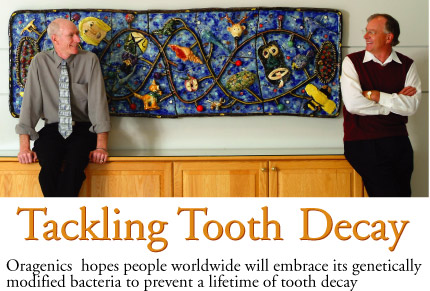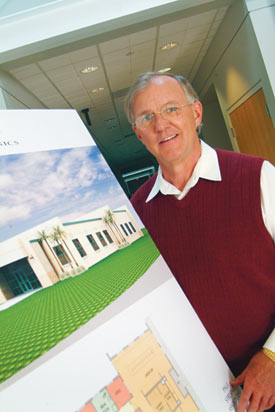|
|

downloadable
pdf
by
Nancy Walsh
Tooth
decay. The Surgeon General has called it a “silent epidemic.”
It’s the most common childhood disease, five times more
common than asthma. By first grade, half of American schoolchildren
already have a cavity. By age 17, it’s 78 percent. More
than 51 million school hours are lost each year to dental-related
illness.
We’ve always been told that sugar causes cavities, but
it’s really lactic acid that does the damage. A bacterium
in our mouths called Streptococcus mutans converts sugar to
lactic acid, which eats tooth enamel.
“Most studies suggest that of the 500 or so bacterial
species in the mouth, Streptococcus mutans causes the majority
of decay,” says University of Florida oral biology Professor
Jeffrey Hillman.
After more than two decades researching S. mutans, Hillman
found a way to genetically tweak a strain of the bacterium
so it doesn’t convert sugar to lactic acid. No lactic
acid, no cavities. The strain he chose is naturally dominant,
ensuring that the modified bacterium will successfully colonize
the tooth surface.
Hillman calls the approach “replacement therapy,”
and he is staking his future on it by taking a hiatus from
academia to found a company called Oragenics to commercialize
the discoveries.
Hillman says humans and S. mutans lived in harmony for eons
until relatively recently, when our diets began to include
more and more refined sugar. That upset the balance, causing
the bacterium to make the excessive acid that causes tooth
decay. In another 100,000 years or so, he says, evolution
would restore that balance, producing a bacterium very similar
to the one he has engineered.
“What we’re trying to do with replacement therapy
is speed up this natural process,” says Hillman, whose
research on the problem has garnered some $16 million over
the years, primarily from the National Institute of Dental
and Craniofacial Research.
|
“The
ideal application would be to treat infants when their
first teeth appear ... If this turns out to be a once-in-a-lifetime
treatment, then you’re talking about a really
good investment.”
—
Jeff Hillman |
“The mechanisms by which bacteria adhere to and grow
on the teeth as biofilm communities, and then convert sugar
to acids that damage the enamel, are extremely complicated,”
says Dennis Mangan, chief of the Infectious Diseases and Immunity
Branch at the NIDCR. “Dr. Hillman’s work exploits
this knowledge in a clever, yet scientifically feasible, manner
and takes us one step closer to the day when everyone will
be free from dental caries throughout their lifetime.”
While Hillman knows the science, he admits that he’s
no businessman. So he has teamed up with Mento “Chuck”
Soponis, Oragenics’ president and CEO. Soponis has more
than 20 years of experience as a biotech executive, most recently
with USBiomaterials Corporation, a firm that develops health-care
products for bone regeneration and dental care.
“How often does a scientist have the opportunity to
eliminate a disease?” Soponis says. “With replacement
therapy, Oragenics can make an enormous impact on world health;
that’s the part I find exciting.”
Oragenics is also developing a “probiotic” that
inhibits the growth of disease-causing bacteria that cause
periodontal, or gum, disease.
Hillman says that of all the bacteria normally residing in
a person’s mouth about a half dozen are the primary
cause of periodontal disease. By studying samples from people
without periodontal disease, Hillman was able to identify
two types of bacteria that prevent the growth of these disease-causing
bacteria.
“At the very least, this probiotic will allow people
to maintain periodontal health,” Soponis says of the
product, which would likely take the form of a daily mouth
rinse.
Hillman and Soponis don’t expect Oragenics’ technologies
to eliminate the need for visits to the dentist. They just
think those visits will be for different procedures.
“There’s a lot more to dentistry than just filling
cavities,” Soponis says. ”And if we can help people
keep their natural teeth longer, we will really be helping
dentists to achieve their goal of better oral health for their
patients.”
Soponis envisions replacement therapy being administered through
a simple procedure in dentists’ office. Patients would
swish an application of the modified bacterium around their
mouths for a few minutes, then chew some sugary gum to activate
it, and they could be cavity-free for life.
 |
In
fall 2004,Oragenics plans to open a new
laboratory facility in Alachua, Florida |
“The ideal application would be to treat infants when
their first teeth appear, although it can be used with people
of all ages,” Hillman says. And although the company
hasn’t determined pricing for the treatment yet, he
adds that “if this turns out to be a once-in-a-lifetime
treatment, then you’re talking about a really good investment.”
Hillman has even engineered the S. mutans bacterium so that
it cannot be transmitted from one person to another through
kissing or sharing eating utensils, ensuring controlled administration
of the product in dentists’ offices.
Replacement Therapy has already undergone laboratory and animal
studies and Soponis says he expects the company to receive
approval of its Investigational New Drug, or IND, application
from the Food and Drug Administration by the end of 2004.
Once the IND is approved, human clinical trials can begin.
Oragenics hopes to have the product on the market by 2009.
Soponis says he is in “continuing conversations”
with companies worldwide that would market and distribute
Oragenics’ product. The estimated market size for replacement
therapy is 200 million people in the United States, 275 million
in Europe and 275 million in Asia.
While much of its resources are focused on oral hygiene treatments,
Oragenics has several other products in the pipeline.
One is a new type of antibiotic, called mutacin 1140, that
could protect against a wide range of disease-causing bacteria,
including staph. In preliminary laboratory studies, mutacin
1140 shows no evidence of pathogen resistance, which has become
a major problem with the six leading classes of antibiotics
in use today.
“Many common pathogens that once succumbed to the six
leading classes of antibiotics used today are now developing
resistant strains at an alarming rate,” Hillman says.
“In fact, the single greatest problem in the use of
antibiotics today is the growing resistance being developed
by target pathogens.”
Mutacin 1140 is still in research and development, with preclinical
animal studies expected to begin later this year. Oragenics
hopes to begin marketing the product by 2008.
Another Oragenics technology, called “change mediated
antigen technology,” or CMAT, identifies genes and the
proteins expressed from them when a living cell changes from
one condition to another, such as when a healthy cell transforms
into a cancerous cell.
CMAT allows researchers to more easily identify “targets”
for new vaccines and diagnostics — an instrumental step
in the study of cancers, autoimmune diseases, coronary and
vascular diseases and plant diseases.
Oragenics’ evolution from a one-man shop to a thriving
start-up company that is constructing its own building is,
in many ways, a textbook example of how a university transfers
its research to the market.
Hillman spent years documenting his research and working with
the university’s Office of Technology Licensing to patent
several of his technologies. At one point, two of Hillman’s
technologies were on UF’s list of the most likely to
succeed.
Once he decided to start his own company rather than have
the university license the technologies to an established
firm, Hillman applied for and was accepted to UF’s Sid
Martin Biotechnology Development Incubator, or BDI, where
promising young companies share scientific and business support
at reduced cost so they can focus scarce resources on developing
their product.
“The BDI is a terrific facility from the standpoint
of development and getting technologies commercialized,”
Hillman says of the incubator, located in Progress Park in
Alachua, Fla. “Allowing the university to work on that
side of things enables us to work on the science. In the end
we all benefit — the company and the university.”
Oragenics is the first “graduate” of the BDI to
build its own facility on the Progress Park campus, a 5,300-square-foot
building expected to open in August.
With four technologies showing promise and a new facility
in which to develop them, Soponis says, “Obviously there
have been many challenges — like finding the right people,
securing funding and working through the regulatory pathways.
But there is tremendous potential here. It is rewarding building
something from nothing. The future is exciting for Oragenics.”
Related Web site:
www.oragenics.com
|

